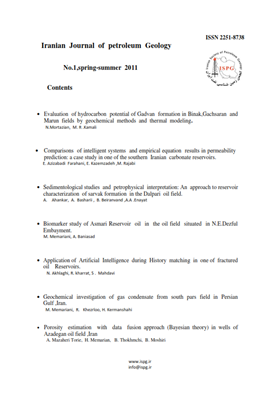Biomarker study of Asmari Reservoir oil in the oil fields situated in N.E. Dezful Embayment
Subject Areas :Mahmud Memariani 1 , Ali reza Bani asad 2
1 -
2 - University of Tehran
Keywords: Dezful Embayment Asmari eastern margin oilfields GC GC-MS petroleum systems. ,
Abstract :
Masjid-e-Solyman, Haft kel, Par-e-Siah and Naft Safid are productive oil fields which are located in mountain front of NE Dezful Embayment. In this research, in order to Geochemical correlation and Petroleum Systems determination of Asmari oils, a few oil samples were subjected to biomarker studies by GC and GC-MS techniques. Review of biomarkers fingerprints indicate two petroleum systems probably are active in studied oilfields. A major petroleum system that has controlled the hydrocarbon generation, migration and accumulation in all studied oilfields and a younger petroleum system, which has caused mixture of oils with another source in Masjed-Soleyman and Par-e-Siah oilfields, Biomarkers fingerprints, Steranes, Hopanes in addition to the main petroleum system. parameters, Pristane to Phytane ratios and also n- alkane's distributions among the studied oils, indicate that the Asamri oils were produced mainly from a marine and marine-carbonate source rock(s), which has been deposited in an anoxic conditions, with kerogen mainly of Type II with little contribution of terrestrial Kerogen (Type III) and oil samples has a maturity about early oil window without any severe biodegradation. 13C isotope values distribution, presence of Oleannane biomarker and slightly differences - mainly from lithological aspects and maturation levels of oils - of Masjid-Soleyman and Par-e-Siah Oils, reveal that, the mixed oils in these two reservoirs have been probably produced from two source rocks, a younger source rock namely Pabdeh Formation (Middle Eocene and Early Oligocene) with less importance of Kazhdumi Formation (Albian) which is the main source rock.


